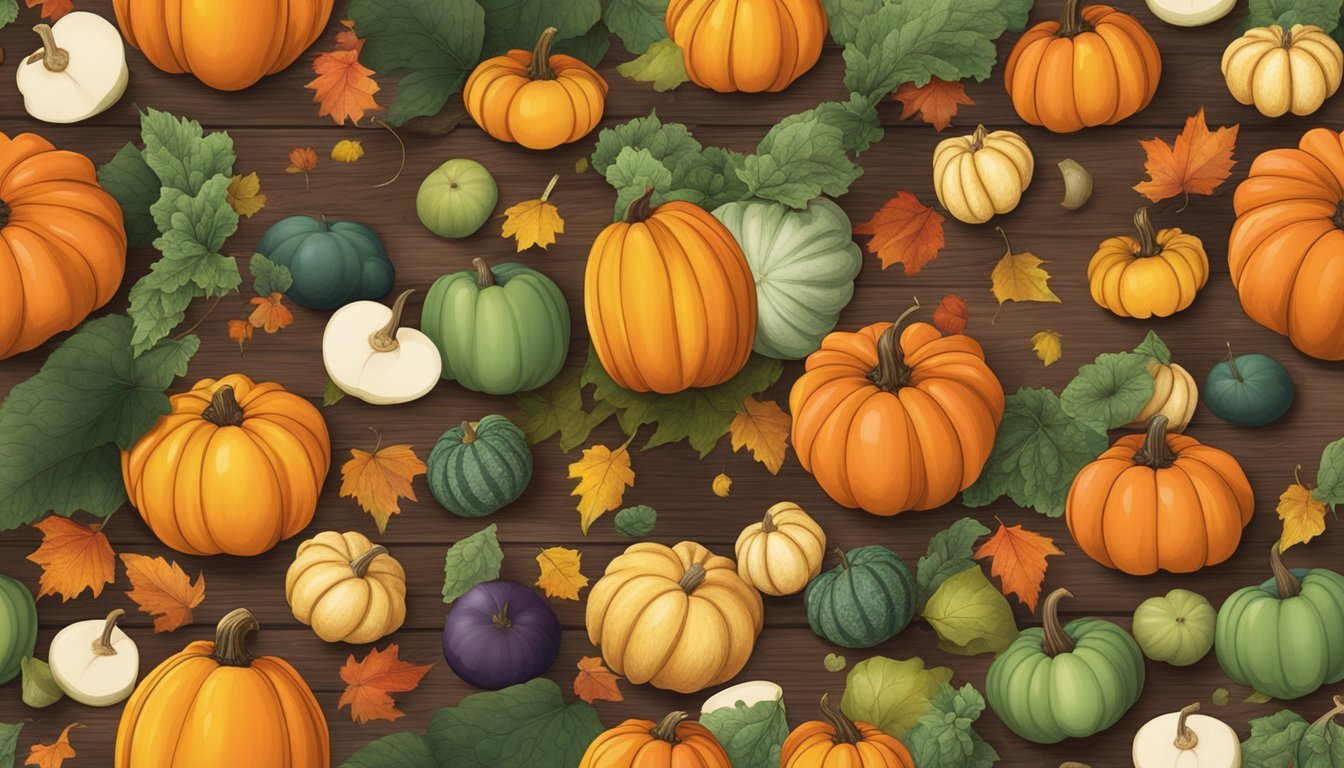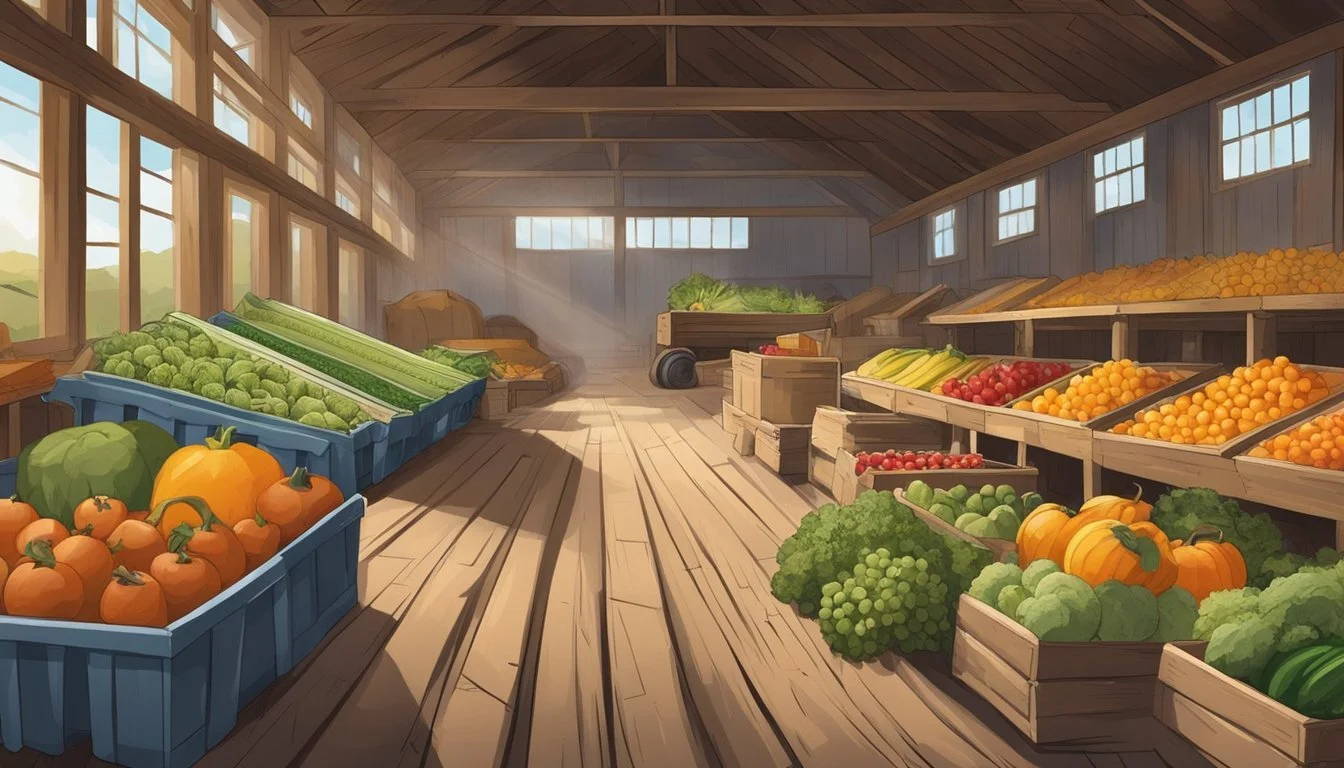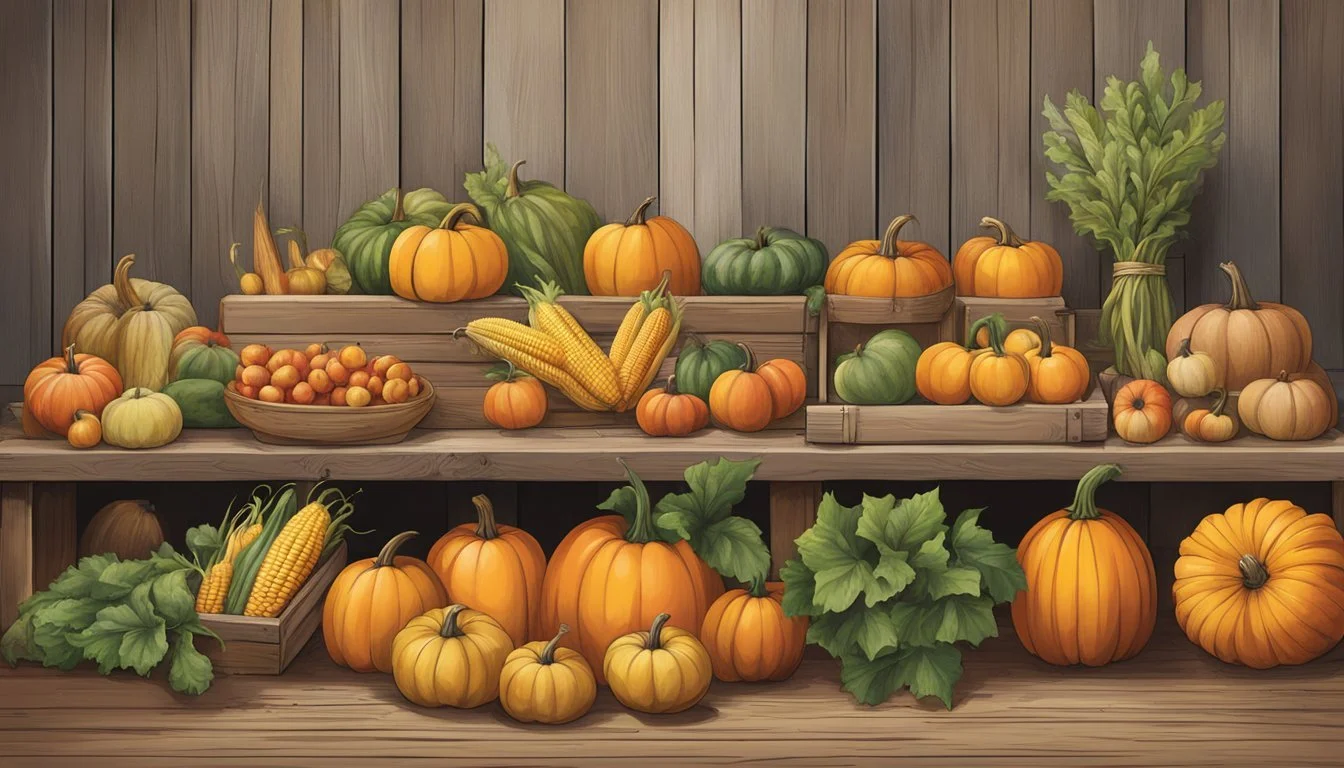Nebraska Seasonal Fruit & Vegetables in November
Your Guide to Fresh Produce
This Article is Part of our Nebraska Seasonal Fruit & Veg Calendar
In Nebraska, the month of November marks a transition period for local produce, as the state's agricultural focus shifts from the summer's vibrant bounty to the more robust offerings suitable for cooler weather. Seasonal eating in Nebraska during this time allows consumers to enjoy produce that is at its peak of freshness and flavor. The agricultural landscape of the state is diverse, with November being a prime time for harvesting a variety of squashes, which have become synonymous with autumn's harvest. These include butternut, spaghetti, amber cup, butter cup, acorn, Crenshaw, and hubbard squashes. Embracing the season's produce not only supports local farmers and the economy but also ensures a rich palette of flavors and nutrients.
Access to fresh fruits and vegetables is still abundant despite the approach of winter. As the seasonal cycle progresses, the hearty vegetables that thrive in Nebraska's climate become readily available. These nutrient-dense selections are essential for winter menus, offering both flavor and health benefits to the locals. The emphasis on seasonal produce consumption during this period fosters a deeper connection between residents and their food sources, promoting sustainability and a more intimate understanding of food seasonality in Nebraska.
Understanding Nebraska's Growing Season
Nebraska's diverse climate significantly impacts its agriculture, with varying growing seasons that cater to a wide array of produce. Each season plays a crucial role in the cultivation and harvesting cycles, deeply influencing the local farming and the state's economy.
Seasonal Overview
Nebraska experiences four distinct seasons, which are an essential framework for agricultural activities. Spring and summer are crucial for planting and growth, while fall and winter generally mark the transition to harvesting and preparation for the next cycle. The growing season can begin as early as April and extend until the first frost in October.
Effect of Climate on Produce
The climate in Nebraska ranges from hot summers to cold winters. Summers provide optimal conditions for warm-season vegetables and fruits, whereas the cooler temperatures of spring and fall are suitable for crops like squash and pumpkins. Climate variability necessitates adaptable planting schedules and crop selections.
Role of Local Farming
Local farms are the backbone of Nebraska's produce supply, delivering fresh vegetables and fruit to communities. Local farmers employ crop rotation and sustainable practices to ensure year-round productivity, with grocery stores and farmers markets being key sources for locally-grown produce.
Agriculture and Economy
Agriculture is a driving force within Nebraska's economy. The state's Department of Agriculture supports initiatives that boost local produce availability, reinforcing the connection between the health of the state's agriculture and its overall economic vitality.
Harvest Cycles
Harvesting cycles in Nebraska are tuned to the seasons, with farmers harvesting different produce as they come into season. Strategic planting ensures a continuous supply of fresh produce, with succession planning integral to meet both market demand and maintain soil health.
November Specifics
In November, Nebraska transitions into winter, wrapping up the fall harvest season. Although many popular crops are out of season, farms may still offer hearty vegetables such as carrots and potatoes. The approach of winter signals the end of the main growing season, with farmers preparing for the next year's spring planting.
Seasonal Fruits in November
In Nebraska, November brings a reduction in the variety of fruits available, but several hearty options still offer a burst of flavor and nutrition. Consumers can find a selection of local fruits that thrive in the cooler climate.
Common Fruit Types
During November, common fruit varieties that reach peak ripeness in Nebraska include apples (how long do apples last?), pears, persimmons, and cranberries. Each fruit boasts its own unique texture and taste:
Apples: A diverse range of apples is available, differing in sweetness and crispness.
Pears: Commonly found in Nebraska, pears vary from buttery and soft to crisp and tart.
Persimmons: These are rich and sweet with a silky texture, a true autumn delicacy.
Cranberries: Known for their tart flavor, they are commonly used in sauces and baked goods.
Fruit Selection Tips
When selecting fresh fruit, one should look for:
Apples and Pears: Firmness and an absence of bruises. The skin should be smooth with a consistent color.
Persimmons: A deep color and slight give under pressure indicate ripeness.
Cranberries: Vibrant color and firmness; they should bounce if dropped.
Health Benefits
Fruits available in November pack a nutrition-rich punch. They provide essential nutrients and are high in fiber, which can aid in digestion. For example:
Apples: Excellent source of vitamin C and fiber.
Pears: High in fiber and vitamin K.
Persimmons: Rich in vitamins A and C.
Cranberries: Good for urinary tract health and high in vitamin C.
Local Specialties
Nebraska orchards and local markets often highlight their own specialty varieties of apples and pears. These local selections offer a chance to experience the full breadth of flavors that the state's fruit can exhibit. Fresh fruit from local sources not only supports Nebraska's economy but also ensures consumers are getting the freshest produce possible.
Seasonal Vegetables in November
In November, Nebraska's farms harvest a rich variety of vegetables that are known for their robust flavor and nutritional value. Local markets are abundant with fresh produce, including various root vegetables and hearty greens.
Common Vegetable Types
November’s harvest in Nebraska includes a selection of root vegetables and greens known for their ability to withstand the cooler climate. Consumers can find:
Squash: Varieties such as butternut, acorn, and spaghetti squash.
Potatoes: A staple with multiple local varieties.
Kale: Hardy and nutritious, kale thrives in the fall weather.
Brussels Sprouts (how long do brussels sprouts last?): These small, leafy green vegetables are mature and ready for harvest.
Cabbage: Offering different variants like red and green cabbage, known for their hearty leaves.
Root Vegetables: Such as beets, turnips, and carrots are at their peak.
Vegetable Selection Tips
When selecting November vegetables, look for:
Firmness: Especially with root vegetables and squash, indicating freshness.
Vibrant Colors: Bright colors often mean the vegetables are ripe and full of flavor.
Heavy for Their Size: A sign of juiciness in squash and other vegetables.
Health Benefits
Vegetables harvested in November are typically dense in nutrients and rich in flavor. They offer:
Antioxidants: Found in kale and Brussels sprouts, aiding in body repair and wellness.
Vitamins: A, C, and K, prevalent in greens and squashes, support immune health.
Fiber: Essential for digestive health, found in root vegetables and cabbages.
Local Specialties
Nebraska’s farms contribute some local specialties that are sought after for their unique flavors. These include:
Heirloom potato varieties that are exclusive to the region.
Kale and cabbages that benefit from the crisp November climate, enhancing their taste.
Squashes that are celebrated for their versatility in fall dishes.
Preparing and Storing Seasonal Produce
Maintaining the freshness and extending the shelf life of Nebraska's seasonal produce in November requires proper cleaning, storage, and usage methods. This can ensure that fruits and vegetables retain their flavor and nutritional value.
Cleaning and Preparation
When handling November's seasonal produce, like squashes and root vegetables, one should thoroughly wash them to remove dirt and any residual pesticides. A soft brush can be used for items with tougher skins, and care should be taken to dry produce completely before storage to prevent mold growth. Produce should be cut and prepared using clean utensils and surfaces to minimize the risk of cross-contamination.
Storing for Freshness
To store the produce for optimal freshness, consider the following strategies:
Squashes: Store in a cool, dark place with good ventilation. They can last up to a month when kept at 50-60°F.
Root vegetables (like turnips and potatoes): Keep in a dark, cool environment separate from fruits that produce ethylene gas like apples, which can cause them to spoil faster.
Apples: Best kept in the refrigerator, where they can stay crisp for several weeks.
A high humidity level is crucial for most vegetables to prevent shriveling, and refrigeration can help in extending shelf life for items like apples.
Recipe Ideas and Usage
The seasonal produce available in Nebraska during November is suited for a variety of cooking and baking techniques. Squashes can be roasted to enhance their natural sweetness, while root vegetables are excellent when boiled or mashed and are commonly used in hearty soups and stews. Apples can be used in both sweet (like pies and crumbles) and savory (like chutneys and salads) dishes. Their versatility ensures that they can be a delightful part of many meals throughout the season.
Beyond the Grocery Store
Nebraska residents have ample opportunities to access fresh fruits and vegetables outside traditional retail environments. These alternatives provide not just freshness but also a closer connection to the local agricultural community.
Farmers' Markets
Farmers' markets in Nebraska offer a seasonal array of fresh produce directly from the producers. Shoppers find a variety of November's bounty, which might include winter squashes and root vegetables. They also serve as a community hub where consumers can interact with local farmers. The markets typically run on specific days of the week, enabling regular access to fresh fruit and vegetables.
Community Supported Agriculture (CSA)
CSAs are partnerships where consumers subscribe to receive a share of the harvest from local farms. Members obtain a selection of fresh vegetables and occasionally fruit, fostering a strong community-agriculture bond. For many Nebraskans, CSA programs are a reliable source of seasonal produce, and they also help sustain local farming operations.
Home Gardening
For those with a green thumb, home gardening in Nebraska allows for personal control over crop selection and growing practices. Although November's cold weather limits active growing, it's an opportune time for planning next season's garden and ordering seeds. Some hardy vegetables, like kale and Brussels sprouts, might still thrive in a well-tended autumn garden.
Produce Subscription Boxes
Subscription box services are increasingly popular, providing regular delivery of fresh vegetables and sometimes fruit to one's doorstep. These boxes often source from local and regional farms, ensuring the produce is seasonal and fresh. They are convenient for consumers who cannot regularly attend farmers' markets or participate in a CSA.
Conclusion
In Nebraska, November marks a transition period for agricultural production, reflecting a time when the bounty of fall harvests concludes and preparation for the colder months begins. Individuals who focus on eating seasonally can benefit from the rich nutritional value found in the produce that is harvested during this late autumn month.
Seasonal vegetables in November typically include a variety of hardy squashes and root vegetables. The table below outlines common options:
Vegetables Availability Butternut Squash (how long does butternut squash last?) Available Spaghetti Squash Available Amber Cup Squash Available Butter Cup Squash Available Acorn Squash Available Hubbard Squash Available
These vegetables offer robust flavors and are well-suited for hearty meals, which is fitting as the climate cools. They are rich in vitamins, minerals, and dietary fiber, aligning with a nutritional diet.
While fruit selections may dwindle in November, certain types, such as late apples, can still be found. They provide a source of vitamins and are versatile for various culinary uses, from fresh eating to baking.
Nebraska's consumers are encouraged to visit local farmers markets or grocery stores to procure these items, ensuring freshness and supporting the local economy. By doing so, they participate in a sustainable consumption cycle that benefits not only their health but also the environment and community agricultural endeavors.







